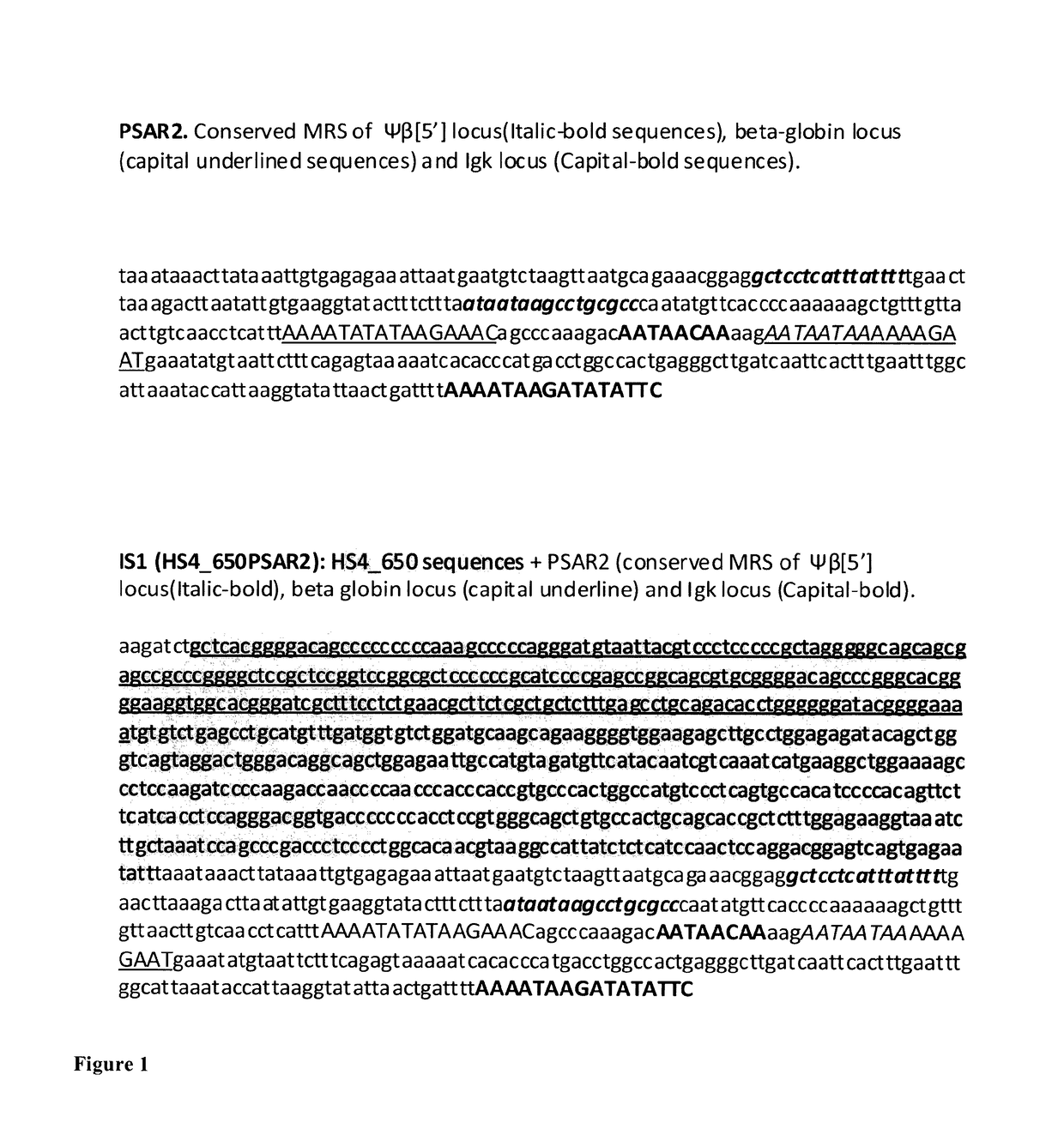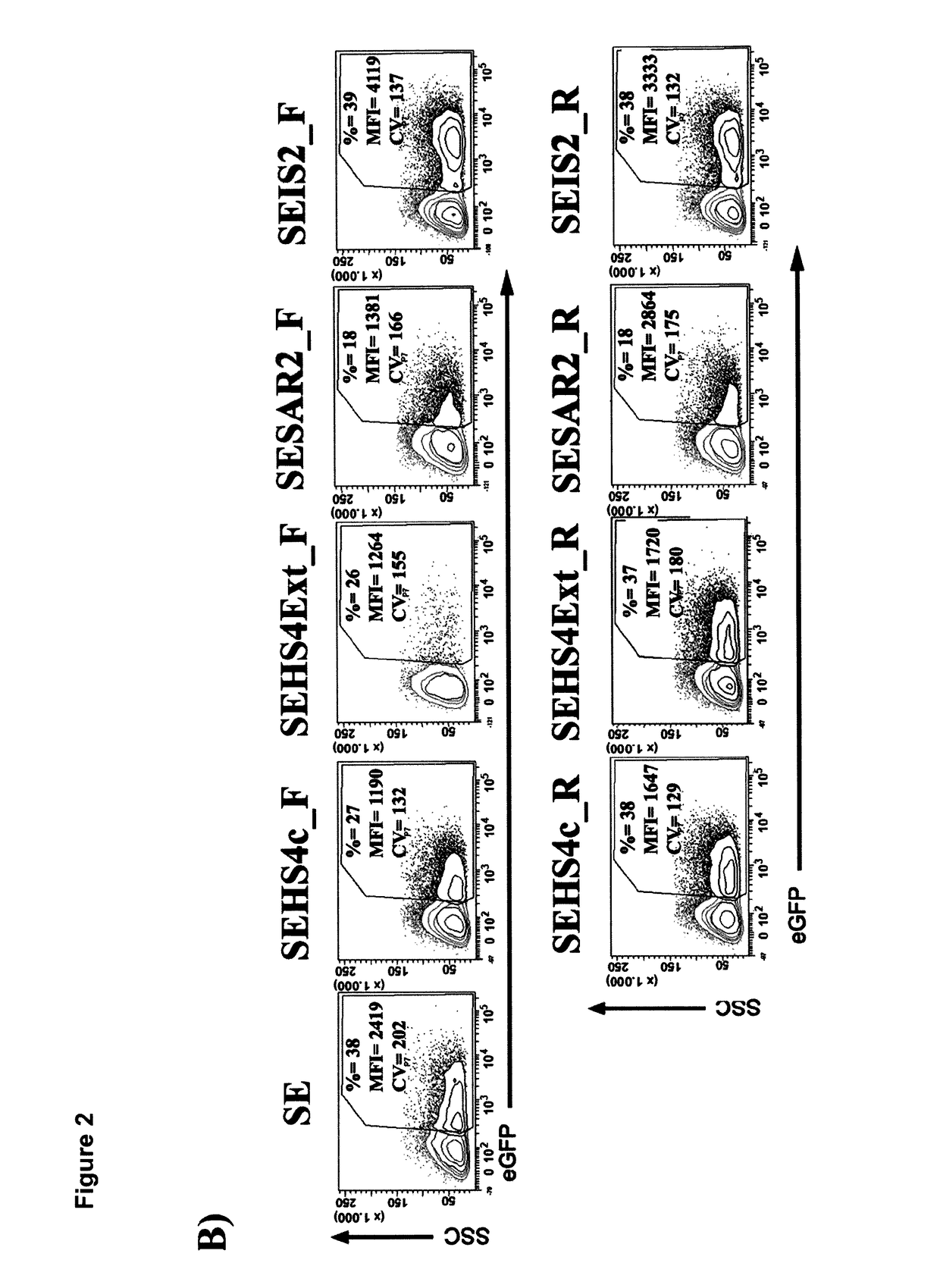Insulator to improve gene transfer vectors
a technology of gene transfer vectors and insulators, which is applied in the direction of nucleic acid vectors, reverse transcribing rna viruses, biochemistry apparatus and processes, etc., can solve the problems of loss of expression, difficult control of transgene expression, and hampered gene transfer vectors, so as to avoid vector silencing, enhance expression, and increase expression
- Summary
- Abstract
- Description
- Claims
- Application Information
AI Technical Summary
Benefits of technology
Problems solved by technology
Method used
Image
Examples
example 1
ion of the Synthetic SAR2 and the IS2 Elements
[0084]M / SAR elements are abundant, highly conserved non-coding DNA sequences that play important roles in defining independent chromatin domains and that were originally described by its ability to bind to the nuclear matrix. M / SARs can act by shielding a locus (or transgene) from the effects of the surrounding chromatin and also from the effects of long distance enhancers. These elements have been used to improve transgene expression pattern of retroviral vectors. However, they are very long to combine with other sequences (such as HS4) to improve insulation properties of retroviral vectors without affecting their titer. We have designed a 428 bp synthetic M / SAR element (named SAR2) that contains 4 MRS from 3 different human chromosome regions, the IgK locus, the β-globin locus and the ψβ globin locus (FIG. 1A). In addition, we have constructed another synthetic element (named IS2) combining this SAR2 element with a previously described...
example 2
lement Enhances Transgene Expression Levels of Lentivirus and Reduces the Effect of the Chromatin on Its Expression Pattern
[0085]LV are the most effective tools for the stable gene delivery, however under some circumstances, transgene expression is either silenced or influenced by sequences neighboring the site of integration. In order to study the effect of the IS2 insulator on LVs gene silencing, we constructed several LVs where this element were inserted in the LV 3′LTR in forward and reverse orientation (FIG. 2B; SIES2_F and SEIS2_R). In order to be able to compare with other insulator previously described, we also inserted the 250 bp HS4 core (HS4c) and the 400 bp HS4 (HS4ext) in identical position (SEHS4_F, SEHS4_R, SEHS4Ext_F and SEHS4Ext_R). In addition we inserted the SAR2 (SESAR2_F and SESAR2_R) just before the 3′LTR to mimic the previously reported configuration of RV incorporating M / SAR elements (11, 12). We first analyzed the transgene expression pattern of the differen...
example 3
s Containing the IS2 Insulator are Resistant to Transgene Silencing in Stem Cells
[0086]To investigate the insulating barrier activity of the SAR2 and IS2 elements, we transduced hESCs with the SEIS2_F, SEIS2_R, SESAR2_F and SESAR2_R LVs and followed eGFP expression for 30 days. The hESCs were also transduced with the SEHS4c_F, SEHS4c_R, SEHS4Ext_f and SEHS4Ext_R LVs In order to compare the barrier activity of the SAR2 and IS2 element with previously described insulators (HS4c and HS4Ext). As can be observed in FIG. 3, while most of the hESCs transduced with the SE LV lost eGFP expression (from 38% to 9%), IS2-containing LVs (SEIS2_R and SEIS2_F) kept eGFP expression almost intact (from 39% to 27% in the forward orientation and from 38% to 38% in the reverse orientation) (FIG. 3 right hand plots). However, neither the SAR2 nor the HS4c elements were able to avoid silencing of the SE vector in this cell line. Only the HS4Ext in the reverse orientation was able to reduced transgene sil...
PUM
| Property | Measurement | Unit |
|---|---|---|
| nucleic acid sequence | aaaaa | aaaaa |
| length | aaaaa | aaaaa |
| nucleic acid | aaaaa | aaaaa |
Abstract
Description
Claims
Application Information
 Login to View More
Login to View More - R&D
- Intellectual Property
- Life Sciences
- Materials
- Tech Scout
- Unparalleled Data Quality
- Higher Quality Content
- 60% Fewer Hallucinations
Browse by: Latest US Patents, China's latest patents, Technical Efficacy Thesaurus, Application Domain, Technology Topic, Popular Technical Reports.
© 2025 PatSnap. All rights reserved.Legal|Privacy policy|Modern Slavery Act Transparency Statement|Sitemap|About US| Contact US: help@patsnap.com



